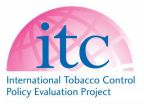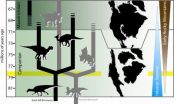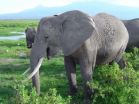(Press-News.org) The greatest risk factor for Alzheimer's disease (AD) is advancing age. By age 85, the likelihood of developing the dreaded neurological disorder is roughly 50 percent. But researchers at the University of California, San Diego School of Medicine say AD hits hardest among the "younger elderly" – people in their 60s and 70s – who show faster rates of brain tissue loss and cognitive decline than AD patients 80 years and older.
The findings, reported online in the August 2, 2012 issue of the journal PLOS One, have profound implications for both diagnosing AD – which currently afflicts an estimated 5.6 million Americans, a number projected to triple by 2050 – and efforts to find new treatments. There is no cure for AD and existing therapies do not slow or stop disease progression.
"One of the key features for the clinical determination of AD is its relentless progressive course," said Dominic Holland, PhD, a researcher at the Department of Neurosciences at UC San Diego and the study's first author. "Patients typically show marked deterioration year after year. If older patients are not showing the same deterioration from one year to the next, doctors may be hesitant to diagnose AD, and thus these patients may not receive appropriate care, which can be very important for their quality of life."
Holland and colleagues used imaging and biomarker data from participants in the Alzheimer's Disease Neuroimaging Initiative, a multi-institution effort coordinated at UC San Diego. They examined 723 people, ages 65 to 90 years, who were categorized as either cognitively normal, with mild cognitive impairment (an intermediate stage between normal, age-related cognitive decline and dementia) or suffering from full-blown AD.
"We found that younger elderly show higher rates of cognitive decline and faster rates of tissue loss in brain regions that are vulnerable during the early stages of AD," said Holland. "Additionally cerebrospinal fluid biomarker levels indicate a greater disease burden in younger than in older individuals."
Holland said it's not clear why AD is more aggressive among younger elderly.
"It may be that patients who show onset of dementia at an older age, and are declining slowly, have been declining at that rate for a long time," said co-author Linda McEvoy, PhD, associate professor of radiology. "But because of cognitive reserve or other still-unknown factors that provide 'resistance' against brain damage, clinical symptoms do not manifest till later age."
Another possibility, according to Holland, is that older patients may be suffering from mixed dementia – a combination of AD pathology and other neurological conditions. These patients might withstand the effects of AD until other adverse factors, such as brain lesions caused by cerebrovascular disease, take hold. At the moment, AD can only be diagnosed definitively by an autopsy. "So we do not yet know the underlying neuropathology of participants in this study," Holland said.
Clinical trials to find new treatments for AD may be impacted by the differing rates, researchers said. "Our results show that if clinical trials of candidate therapies predominately enroll older elderly, who show slower rates of change over time, the ability of a therapy to successfully slow disease progression may not be recognized, leading to failure of the clinical trial," said Holland. "Thus, it's critical to take into account age as a factor when enrolling subjects for AD clinical trials."
The obvious downside of the findings is that younger patients with AD lose more of their productive years to the disease, Holland noted. "The good news in all of this is that our results indicate those who survive into the later years before showing symptoms of AD will experience a less aggressive form of the disease."
###Co-authors are Rahul S. Desikan, Department of Radiology, UCSD and Anders M. Dale, Departments of Neurosciences and Radiology, UCSD.
Funding for this research came, in part, from the National Institutes of Health (grants R01AG031224, R01AG22381, U54NS056883, P50NS22343 and P50MH08755); the National Institute on Aging (grant K01AG029218) and the National Institute of Biomedical Imaging and Bioengineering (grant T32EB005970).
Alzheimer's cognitive decline slows in advanced age
2012-08-03
ELSE PRESS RELEASES FROM THIS DATE:
Plant-based compound slows breast cancer in a mouse model
2012-08-03
The natural plant compound phenethyl isothiocyanate (PEITC) hinders the development of mammary tumors in a mouse model with similarities to human breast cancer progression, according to a study published August 2 in the Journal of the National Cancer Institute.
Edible plants are gaining ground as chemopreventative agents. PEITC has shown to be effective as a chemopreventative agent in mice for colon, intestinal, and prostate cancer, by inducing apoptosis.
In order to determine the efficacy of PEITC in mammary tumors in mice, Shivendra V. Singh, Ph.D., of the University ...
Cuckoo tricks to beat the neighborhood watch
2012-08-03
To minimise the chance of being recognised and thus attacked by the birds they are trying to parasitize, female cuckoos have evolved different guises. The new research, funded by the Natural Environment Research Council, was published today, 03 August, in the journal Science.
The common cuckoo (Cuculus canorus) lays its eggs in the nests of other birds. On hatching, the young cuckoo ejects the host's eggs and chicks from the nest, so the hosts end up raising a cuckoo chick rather than a brood of their own. To fight back, reed warblers (a common host across Europe) have ...
Breast cancer charity under fire for overstating the benefits of screening
2012-08-03
Professors Lisa Schwartz and Steven Woloshin of the Center for Medicine and the Media at The Dartmouth Institute for Health Policy and Clinical Practice argue that last year's breast cancer awareness month campaign by Susan G Komen for the Cure "overstates the benefit of mammography and ignores harms altogether."
Their views are published on bmj.com today as part of an occasional series highlighting the exaggerations, distortions, and selective reporting that make some news stories, advertising, and medical journal articles "not so."
A growing and increasingly accepted ...
5-year survey confirms Uruguay's world-leading tobacco control strategy is delivering results
2012-08-03
Implementation of graphic labels at 80% of the pack size front and back led to increased awareness of the risks of smoking
Ban on multiple brand presentations reduced smokers' false beliefs that some cigarettes (e.g., "light" or "mild" cigarettes) are less harmful
Strong support for tobacco control policies among smokers
(Thursday August 2nd, 2012, Montevideo, Uruguay and Waterloo, Ontario, Canada): The International Tobacco Control Policy Evaluation Project (the ITC Project) today launched a new report on the effectiveness of tobacco control policies in Uruguay. ...
Mountains, seaway triggered North American dinosaur surge
2012-08-03
ATHENS, Ohio (Aug. 2, 2012)—The rise of the Rocky Mountains and the appearance of a major seaway that divided North America may have boosted the evolution of new dinosaur species, according to a new Ohio University-led study.
The finding, published today in the journal PLOS ONE, may explain patterns of evolution and migration of North American duck-billed and horned dinosaurs in the years leading up to their extinction 65 million years ago, said Terry Gates, a postdoctoral researcher with Ohio University's Heritage College of Osteopathic Medicine who is lead author on ...
Close to the bone
2012-08-03
A genetic screening approach to studying bone disease has found nine new genes associated with bone health and suggests a new way to discover genes that may be implicated in human skeletal diseases. A collaborative study of the mineral content, strength and flexibility of bones has found clues to the cause of bone disorders such as osteoporosis, osteogenesis imperfecta, and high bone density syndromes. The study, which brings together specialist skills in mouse gene deletion and bone measurement to assess the strength of bones in 100 mutant mouse lines, is the largest ...
Modest weight loss can have lasting health benefits, research shows
2012-08-03
ORLANDO, Fla. – Overweight and obese individuals can achieve a decade's worth of important health benefits by losing just 20 pounds, even if they regain the weight later that decade, according to research presented at the American Psychological Association's 120th Annual Convention. With a focus on psychology's role in overcoming the national obesity epidemic, the session also examined research that indicates foods high in sugar and fat could have addictive properties.
Rena Wing, PhD, professor of psychiatry and human behavior at Brown University's Alpert Medical School ...
Study shows how elephants produce their deep 'voices'
2012-08-03
African elephants are known to be great communicators that converse with extremely low-pitched vocalizations, known as infrasounds, over a distance of miles. These infrasounds occupy a very low frequency range—fewer than 20 Hertz, or cycles, per second—that is generally below the threshold of human hearing.
Now, a new study shows that elephants rely on the same mechanism that produces speech in humans (and the vocalizations of many other mammals) to hit those extremely low notes. Christian Herbst from the University of Vienna, along with colleagues from Germany, Austria ...
NASA satellites see Tropical Storm Saola and Typhoon Damrey arm-in-arm near China
2012-08-03
Tropical Storm Saola and Typhoon Damrey appear on NASA satellite imagery to be arm-in-arm as they enter China on August 2.
NASA's Terra satellite passed over both tropical cyclones and captured them in one image, using the Moderate Resolution Imaging Spectroradiometer (MODIS) instrument onboard. MODIS captured a visible image on August 2, 2012 at 0245 UTC that showed the southern extent (or arm) of Typhoon Damrey, making landfall north of Shanghai, feeding into the northern extent (or arm) of Tropical Storm Saola, making landfall south of Shanghai. MODIS imagery also ...
Bacteria-immune system 'fight' can lead to chronic diseases, study suggests
2012-08-03
ATLANTA – Results from a study conducted at Georgia State University suggest that a "fight" between bacteria normally living in the intestines and the immune system, kicked off by another type of bacteria, may be linked to two types of chronic disease.
The study suggests that the "fight" continues after the instigator bacteria have been cleared by the body, according to Andrew Gewirtz, professor of biology at the GSU Center for Inflammation, Immunity and Infection. That fight can result in metabolic syndrome, an important factor in obesity, or inflammatory bowel disease ...



